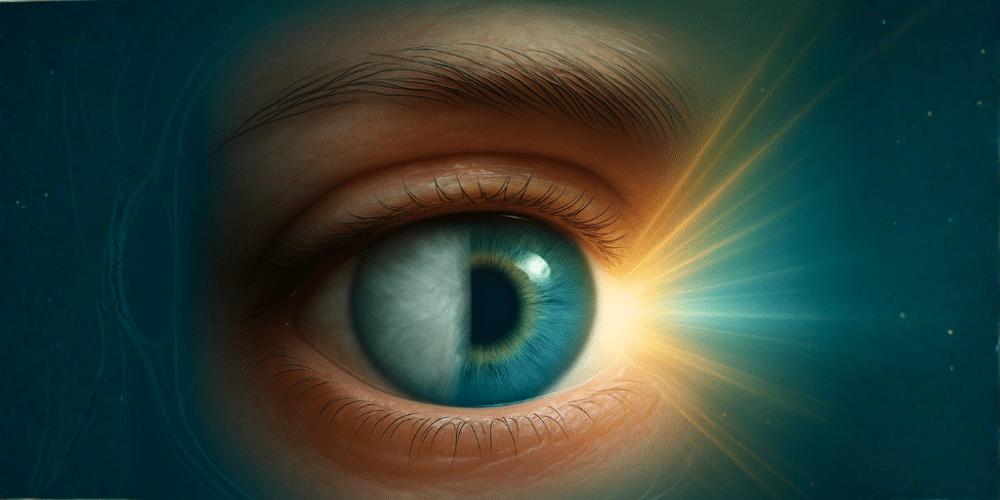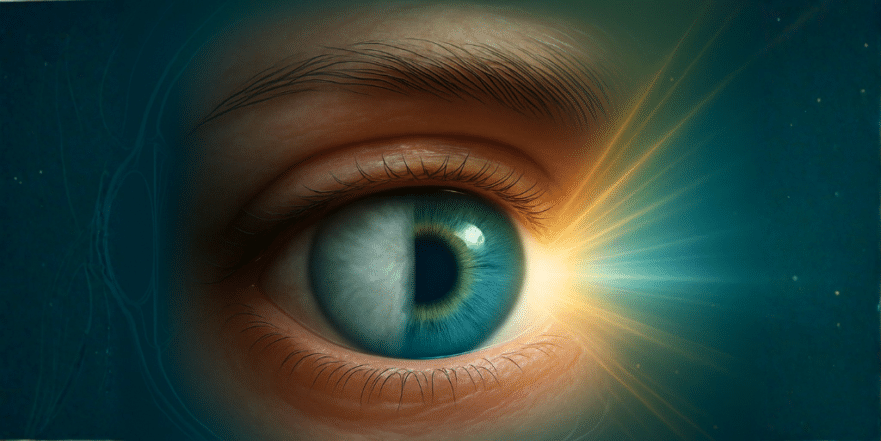
Is driving at night becoming a challenge? Do the headlights of oncoming cars seem more blinding than they used to? You might chalk it up to just getting older, but it could be an early sign of cataracts. Today, we’re going to dive deep into the five early warning signs that can appear years before a diagnosis, and more importantly, what you can do to slow them down. We’ll also bust some common myths and clarify the one mistake that accelerates their appearance the most.
So, what exactly are cataracts, and why will almost all of us get them if we live long enough? A cataract is the progressive clouding of the crystalline lens, which is the natural, transparent lens inside your eye that helps you focus on images. Think of it like the windshield of your car slowly getting foggier and foggier. At first, you barely notice it, but eventually, seeing through it becomes increasingly difficult. The surprising part is that cataracts aren’t a rare disease. By age 65, nearly half of all people have some degree of cataract formation, and by age 75, that number jumps to almost 90%. The key difference from person to person is when they start noticing the symptoms and how much it affects their daily life. The good news? Unlike many other eye conditions, cataracts have a highly effective solution. But before we get to that, let’s learn to spot the signs early, because the sooner you know, the more time you have to take protective measures. (Based on the insights of Dr. Alberto Sanagustín)
Key Takeaways
- What They Are: Cataracts are a progressive clouding of your eye’s natural lens, a very common part of the aging process.
- Early Signs: Be aware of progressive blurry vision, increased glare (especially at night), faded or yellowed colors, double vision in one eye, and frequent changes in your glasses prescription.
- Prevention is Key: You can significantly slow their progression by protecting your eyes from the sun, quitting smoking, managing blood sugar, and eating a diet rich in antioxidants.
- The Solution: Cataract surgery is one of the safest and most effective medical procedures available today. It’s performed when cataracts begin to interfere with your quality of life.
- Myths vs. Reality: Forget about “miracle eye drops” or waiting for cataracts to “ripen.” Modern treatment is based on your personal needs, not outdated beliefs.
1. Progressive Blurry Vision
The first and most common sign is a gradual blurring of your vision, especially when looking at distant objects. We’re not talking about a sudden blurriness that makes you think you just need to clean your glasses. This is a slow, creeping change that happens over months or even years. It’s so gradual that your brain often adapts, and you might not realize how much vision you’ve lost until someone points it out. You might find it harder to read traffic signs, see the numbers on a bus, or make out the names of shops from a distance. It can feel like you’re constantly looking through a thin layer of mist. A word of caution: if you experience a sudden, rapid, or painful loss of vision, this is not a cataract. It could be a medical emergency like acute glaucoma or a retinal detachment, and you should see a doctor immediately.
2. Excessive Glare and Halos at Night
This second sign is often what gets people’s attention. Do the headlights of oncoming cars seem overwhelmingly bright? Do streetlights have halos or starbursts around them? Have you stopped driving at night because it just feels uncomfortable and unsafe? Pay close attention to this. This isn’t just an inconvenience; it’s a real safety risk. This glare can also happen during the day in bright sunlight. It’s as if your eye’s lens has tiny scratches on it that scatter light in every direction instead of focusing it cleanly. This light scatter is what creates those distracting and dangerous halos. Many people with early-stage cataracts give up night driving without knowing exactly why, simply feeling that it’s no longer safe. The culprit is the increasingly opaque lens that disperses light instead of letting it pass through clearly.
3. Colors Seem Faded or Yellowish
This third sign is more subtle and harder to detect because, like blurry vision, it happens progressively. Colors may start to look dull, washed out, and less vibrant. It’s as if someone has slowly turned down the contrast and saturation on the world around you. The change is so gradual that your brain adapts. You don’t just wake up one day and notice that colors look strange. I once had a patient who, after her cataract surgery, told me she was emotional because she hadn’t remembered the sky was so brilliantly blue. The reason this happens is that the aging lens naturally yellows over time, acting like a built-in yellow or brown filter. This filter primarily blocks blue and violet light, altering your color perception without you even realizing it. Many people only rediscover the true vibrancy of colors after their cataracts are removed.
4. Double Vision in a Single Eye
This fourth sign, known as monocular diplopia, is less common but very specific to cataracts. It’s when you see a double image with only one eye open. If you cover one eye and still see double with the other, it could be an early sign of a cataract. Be careful to distinguish this from binocular diplopia, which is double vision that occurs only when both eyes are open and usually points to a more serious neurological or muscle alignment problem that requires immediate medical attention. With cataracts, the double vision happens because irregularities in the clouding lens can split the light, creating multiple images on the retina. While not everyone with cataracts experiences this symptom, if you do, it’s a fairly characteristic sign that warrants a visit to your eye doctor.
5. Frequent Changes in Your Glasses Prescription
This fifth sign is very telling. Do you feel like you need a new pair of glasses every year because your prescription keeps changing? This constant shift might not be a normal refractive issue; it could be a developing cataract. In its early stages, a cataract can change the refractive index of your lens. Sometimes, it can even make you temporarily more nearsighted, a phenomenon called a “myopic shift.” I’ve seen patients who haven’t been able to read up close without glasses for years suddenly find they can. It seems like a miracle—their vision is improving! But ironically, what appears to be good news is actually a warning sign that a cataract is progressing. If your vision seems to be in constant flux, don’t just keep buying new glasses. Get a comprehensive eye exam to see what’s really going on.
What Speeds Up Cataracts? (And How to Slow Them Down)
While aging is the primary cause of cataracts, certain factors can dramatically speed up the process. The good news is that many of these are within your control.
First, the uncontrollable factors are age and genetics. Simply living longer increases your risk, and if your parents or siblings had early cataracts, you’re more likely to develop them too. But genetics isn’t your destiny. The factors you can control are incredibly important.
- Sun Exposure: This is arguably the most significant modifiable risk factor. Ultraviolet (UV) radiation from the sun damages the proteins in your lens over time. The damage is cumulative, meaning every time you go outside without eye protection, you’re adding a little more stress that your eye can’t fully repair. Think of a clear piece of plastic left in the sun for years—it eventually turns yellow and opaque. The same thing happens to your lens. Always wear sunglasses that offer 100% UVA/UVB protection or are labeled “UV400.” Be wary of dark lenses without a certified UV filter, as they can be worse than no glasses at all; they cause your pupils to dilate, letting more harmful radiation in.
- Smoking: Smoking doubles your risk of developing cataracts. The toxic chemicals and free radicals in tobacco smoke travel through your bloodstream to your eyes, where they accelerate the oxidation and damage of the lens proteins. The more you smoke and the longer you do it, the higher your risk. The best part? When you quit, your risk begins to decrease progressively.
- Poorly Controlled Diabetes: People with diabetes, especially when it’s not well-managed, are two to five times more likely to develop cataracts at an earlier age. High blood sugar levels cause chemical changes within the lens that speed up its clouding. However, if you maintain stable blood glucose levels, you can significantly reduce this risk. It’s not about being perfect, but about working with your doctor to keep your blood sugar and HbA1c levels in a healthy range.
- Other Factors: Long-term use of corticosteroid medications, significant eye trauma, and excessive, chronic alcohol consumption have also been linked to an increased risk of cataracts.
Busting the 5 Biggest Cataract Myths
There’s a lot of misinformation out there. Let’s clear up the five most common myths.
- Myth: Eye drops can dissolve or cure cataracts.
- Reality: This is false. There are no eye drops, medications, or supplements that can reverse or dissolve a cataract once it has formed. The changes to the lens proteins are structural and irreversible. The only definitive treatment is surgery.
- Myth: Reading a lot or using screens causes cataracts.
- Reality: These activities do not cause cataracts. They can cause eye strain, dryness, and fatigue, but they do not cause the lens to become cloudy. Cataracts are caused by aging and the risk factors we’ve discussed.
- Myth: You have to wait for a cataract to be “ripe” before surgery.
- Reality: This is an outdated belief from decades ago when surgical techniques were less advanced. With modern technology, it’s actually better to operate before the cataract becomes overly dense and hard. Today, the main criterion for surgery is not how “mature” the cataract is, but how much it impacts your quality of life.
- Myth: Cataract surgery is dangerous.
- Reality: Cataract surgery is one of the safest and most successful procedures in all of modern medicine, with a success rate between 95% and 98%. Serious complications are very rare. The procedure itself usually takes only 15-20 minutes.
- Myth: Cataracts can grow back after surgery.
- Reality: This is impossible. During surgery, the cloudy natural lens is permanently removed and replaced with a clear, artificial intraocular lens (IOL) that cannot become cloudy. What can happen sometimes is that the thin membrane left behind to hold the IOL can become hazy over time. This is called posterior capsule opacification, and it’s easily, painlessly, and permanently corrected with a quick, in-office laser procedure.
Conclusion: Take Control of Your Vision
We’ve covered a lot of ground, but the message is simple and empowering. While cataracts are a common part of aging, you are not powerless. You can take active steps today to protect your vision and slow their progression. Wear certified sunglasses, maintain a healthy lifestyle, and don’t smoke. Most importantly, pay attention to the early signs. Don’t normalize vision loss as something you just have to live with. If you notice progressive blurriness, glare, or faded colors, schedule an exam with your ophthalmologist. And if the time comes for surgery, know that it is a safe, effective procedure that can restore not just your sight, but your quality of life. Seeing the world clearly isn’t a luxury; it’s your right to continue enjoying life to the fullest.
Source: Dr. Alberto Sanagustín

